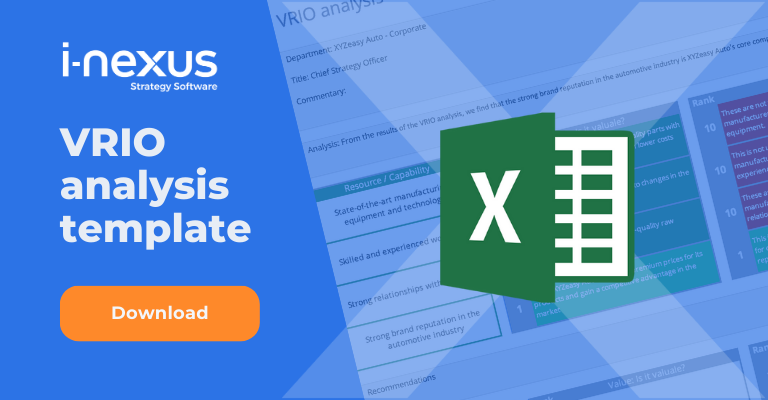Is there a right time to use VRIO? Find out why you should run VRIO after your SWOT analyses and five times your company can put it to use.
VRIO stands for value, rarity, imitable, and organization - but what does it stand for in your business?
Framed around your customer and your organization, it's an analytical tool that puts your internal strengths in a fresh perspective, and ready to use for competitive advantage, after completing the classic SWOT.
Today, we're walking through five ways you can put the VRIO tool to use after running a SWOT.
What is a VRIO Analysis?
Let's start with a VRIO refresher.
VRIO has you assess your business' resources and capabilities for identifying sources of sustainable competitive advantage. In a time where competitive advantage is almost a fantasy, it's one way to find, and act on, one.
The results of the internal analysis should provide clarity on not only the things that work in your favor but also highlight those weaknesses that act as a competitive disadvantage.
The framework focuses on understanding your "VRIO resources". That is achieved by considering four perspectives: Value, Rarity, Imitability, and Organization. If it all goes to plan, you'll avoid competitive parity.
The four components of VRIO

1. Value: The "Value" component assesses whether a specific resource or capability adds significant worth to the company. This involves assessing if the company can take advantage of opportunities or address threats in the market.
A valuable resource can be anything that improves the company's efficiency and products or reduces costs, thereby giving it an edge over competitors.
 2. Rarity: "Rarity" examines how unique a resource or capability is across the industry. The main question is if the resource is only for your company or if others can also access it.
2. Rarity: "Rarity" examines how unique a resource or capability is across the industry. The main question is if the resource is only for your company or if others can also access it.
A resource’s rarity is crucial because it determines the level of competitive advantage it can provide. Common resources offer little to no advantage, as they are readily available to all competitors. In contrast, rare resources can set a company apart and form the basis of a strong competitive position.
3. Imitability: "Imitability," is about how easily other companies can replicate your resource or capability. If your competitors can easily copy or get the same thing, it won't give you a long-term advantage over them.
The more difficult to imitate, the more valuable the resource is. This might include advanced technology, specific expertise, or a unique company culture that is hard for others to copy.
 4. Organization: "Organization" looks at whether the company is structured in a way that can effectively exploit these valuable, rare, and hard-to-imitate resources. This involves having the right systems, processes, and leadership in place to leverage these assets fully.
4. Organization: "Organization" looks at whether the company is structured in a way that can effectively exploit these valuable, rare, and hard-to-imitate resources. This involves having the right systems, processes, and leadership in place to leverage these assets fully.
It's important to have strategic resources and be organized to make the most of them and turn them into competitive advantages.
Building a resource-based view with VRIO
It is the business leader that runs the analysis, but it will also involve members of human resources. HR will be able to provide scoring systems around capabilities and benchmark this in your organization and industry. This is part of their resource-based view (RBV).
Like VRIO, RBV claims that different companies have different resources that are distributed unevenly across the competitive landscape. These resources and capabilities are key to a company's performance and its ability to stand out from competitors.
By using VRIO, your business avoids the all-too-often trap of theory over reality (here the RBV).
How is a VRIO different from a SWOT?
As anyone in a strategic management role can attest, there is an alphabet soup of strategy creation tools you can use.
Knowing what to use and when to use it is important. Even something like VRIO can get confused with SWOT, given both involve an evaluation of internal resources and your competitors.
So, how is a VRIO different from a SWOT analysis?
VRIO focuses on a company's internal strengths. A SWOT analysis addresses internal and external factors, including strengths, weaknesses, opportunities, and threats. This helps determine how well a company can perform.
VRIO examines how internal resources can be used uniquely. SWOT provides a broader view of the organization's position in the external environment.
We'd recommend completing a SWOT analysis first because:
- SWOT gives a broad overview of your internal strengths and weaknesses, along with external opportunities and threats. This bird's eye view sets the stage for the broader strategic landscape before diving into the specifics of internal capabilities with VRIO.
- Through the SWOT, you'll find areas you could focus on, and you'll prioritize them. If the SWOT surfaces a strength that your ability to compete in a new market is unmatched due to your team's network, that warrants further investigation with VRIO.
- By prioritizing the SWOT insights, you'll soon find that not all strengths either deserve to be put through the VRIO model, or if they are, they fail to meet the criteria of Value, Rarity, Imitability, and Organization. That's an efficient approach to narrowing down the most promising candidates.
- SWOT first, VRIO second helps with strategic alignment. There's little use in finding a source of competitive advantage in your grasp, but your strategies ignore it. This will reduce the risk of strategic drift, and factors into the need to keep your strategy agile.
How to Do a VRIO Analysis
Using the VRIO framework is a simple process. Completing this regularly and incorporating it into your strategy creation toolset is one of the ways you're going to find the important long-term competitive advantage you need.
- Identify Resources and Capabilities: Begin by cataloging the company's tangible and intangible assets.
- Value: Evaluate whether these resources and capabilities enable the company to exploit opportunities or neutralize threats.
- Rarity: Determine if these assets are unique to the company or if they are widely available to competitors.
- Imitable: Assess the ease with which rivals can copy or acquire these resources (Imitable).
- Organization: Examine if the company is organized to fully capture the value of these resources.
Examples of five times a company would put VRIO to use

1. Strategic planning sessions
In planning sessions, a VRIO assessment can help leaders choose the most competitive resources and abilities. It guides the allocation of budgets and resources towards areas that promise the highest strategic returns.
2. Evaluating mergers and acquisitions
VRIO helps decide if a company's resources match another company's goals before merging. This analysis is crucial for ensuring a successful integration. By evaluating the compatibility of both companies, VRIO helps identify potential synergies and areas of improvement. Ultimately, this assessment can guide decision-making and lead to a more strategic and beneficial partnership.
This evaluation helps ensure that combining the two companies will enhance their competitive advantage. This ensures that combining them will make the competitive advantage stronger.
3. New market entry
Before entering a new market, companies can use a VRIO analysis to determine if they have unique strengths. These strengths can help them overcome barriers and compete effectively against local competitors.
4. Product development
During product development, VRIO analysis helps the team identify internal strengths that they can use to create unique products. These unique products are difficult for competitors to replicate, giving the company a special advantage in the market.
5. Responding to competitive threats
When facing new competition, a VRIO analysis can demonstrate how a company's unique resources can help maintain its market position. This may include enhancing existing products or developing new strategies. This can involve improving current products or creating new strategies.
Start your VRIO analysis
Whether you're in your planning cycle or in the rush of new product development, there's never a wrong time to work through a VRIO analysis.
To help you through, be sure to download a free copy of our Excel VRIO analysis template.
Learn more about strategy execution
Take the next steps in your journey by exploring our strategy execution resource hub.
About the author
Here at i-nexus, I want to help you develop and find easier, more effective ways to deliver more of your goals, with less effort. As part of that, I'm passionate about creating the best content to overcome your challenges.
If you’d like to talk more about strategy execution, reach out to me at james.milsom@i-nexus.com or connect with me on LinkedIn for the latest insights.



